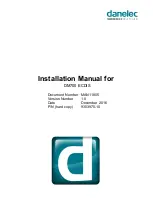
Installation and Operational Instructions for
ROBA-stop
®
-stage Type 8070. _ _ _ _ _
Sizes 8
– 200
(E102 03 000 000 4 EN)
18/11/2022 HW/GC
Chr. Mayr GmbH + Co. KG
Eichenstraße 1, D-87665 Mauerstetten, Germany
Phone: +49 8341 804-0, Fax: +49 8341 804-421
Page 15 of 17
Brake Inspection
(before brake initial operation)
Air gaps inspection (Fig. 2)
Measure the air gap “a” (brake 1 energized) several times
on the circumference between the armature disk (4.2) and
the coil carrier (3). The nominal air gap acc. Table 1 must
be given.
Braking torque inspection
Please compare the requested braking torque with the
torque stated on the Type tag (12).
Release function inspection
by energizing both brake circuits, the brake is residual
torque-free.
Switch function inspection of the release monitoring (9)
with proximity switch
(see page 12)
Hand release function inspection (option)
By deflecting the hand release bracket (10.1) manually, the
friction linings are relieved. The brake is free but for a
residual torque of approx. 5 % of the set braking torque.
The braking torque is not achieved until after the run-in
procedure (approx. 2
– 3 EMERGENCY STOP braking actions)
has been carried out.
Dual Circuit Brake Functional Inspection
The ROBA-stop
®
-stage brake is equipped with a double safety
(redundant) braking system. This means that, should one brake
circuit fail, the braking effect is still maintained.
Testing both brake circuits together and the individual circuits
must be carried out as follows:
DANGER
When carrying out brake circuit tests, under no
circumstances are persons allowed to be under
the moving loads. Please observe the accident
prevention regulations.
If the conveyor shows a significantly longer
braking distance during the single circuit test
than during the test of both brake circuits, the
respective energized brake circuit must also be
de-energized immediately.
The dual circuit braking function is not
guaranteed.
Shut down the conveyor, dismantle the brake if
necessary and check it (air gap, switching
function of the release monitoring, braking
torque and drive dimensioning).
Please observe the warning in the section
„Maintenance”.
Testing both brake circuits with test load from nominal
speed:
1.
Energize both brake circuits and put the drive into
operation.
2.
Trigger an emergency stop (de-energize both circuits) and
check the stopping distance.
Inspection brake circuit 1:
1.
Energize brake circuits 1 and 2 and put the drive into
operation.
2.
De-energize brake circuit 1 (= EMERGENCY STOP) and
inspect the stopping distance. The stopping distance must
be only slightly longer than when testing both brake circuits.
3.
De-energize brake circuit 2.
Inspection brake circuit 2:
1.
Energize brake circuits 1 and 2 and put the drive into
operation.
2.
De-energize brake circuit 2 (= EMERGENCY STOP) and
inspect the stopping distance. The stopping distance must
be only slightly longer than when testing both brake circuits.
3.
De-energize brake circuit 1.
Attention
If a single circuit inspection is carried out that
differs from the above description, the load may
"sag".
This could be the case if a brake circuit of a
drive loaded with the test load is energized.
When a brake circuit is released, there may be
a brief drop in braking torque just below the
nominal torque.



































